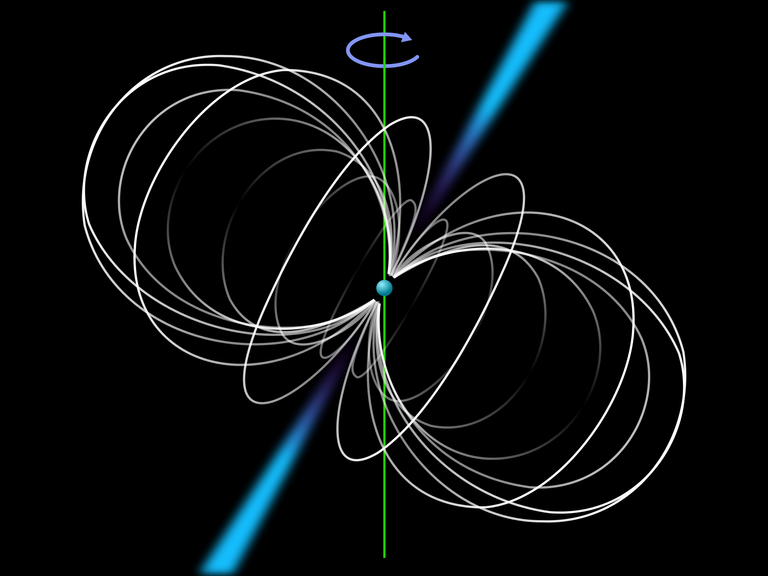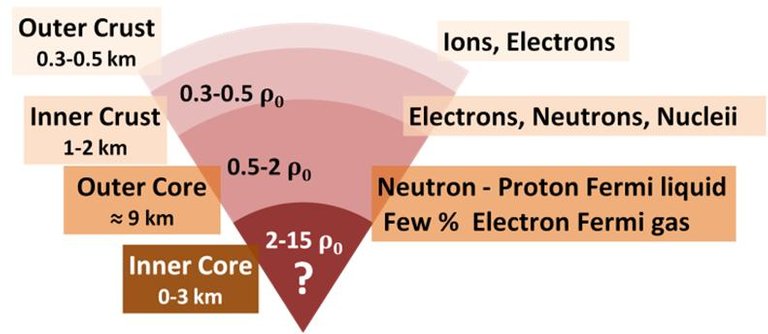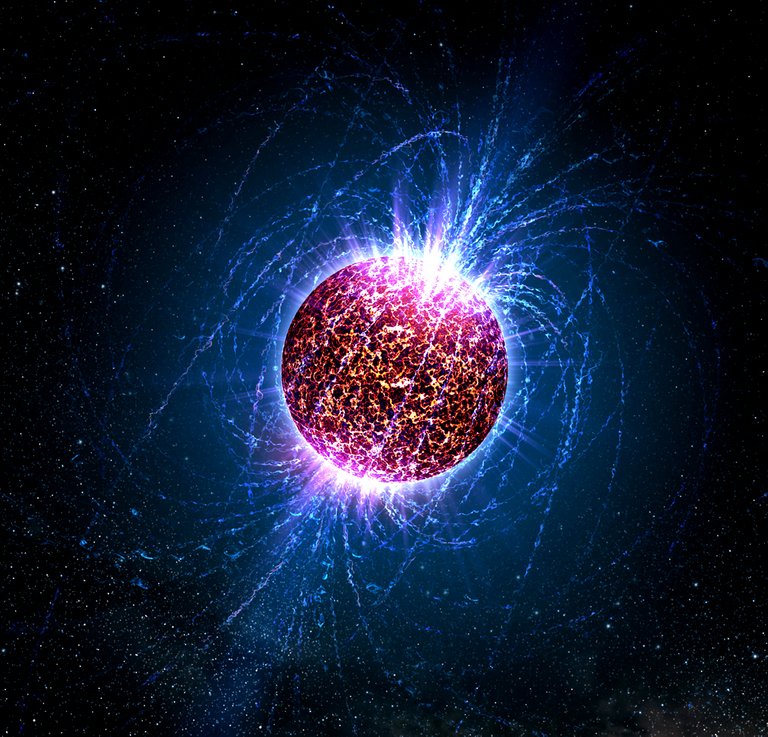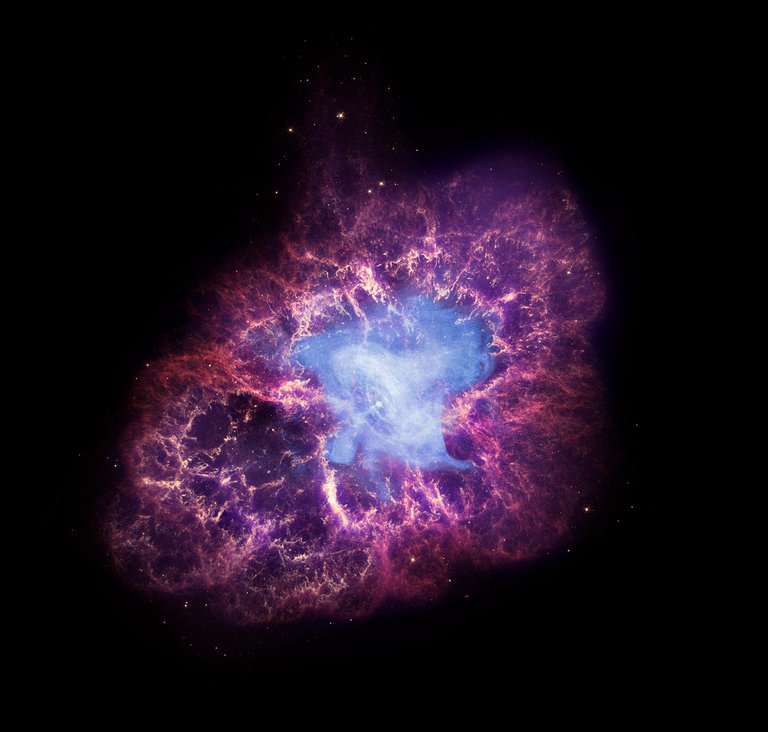In modern physics and astrophysics neutron stars and black holes are one of the most interesting topics.Theory of relativity ensures the possibility of the existence of such kind of objects theoretically. Through the development of technologies, today it is possible to detect such kind of object. As I am writing about neutron stars, so the first question arises is what is a neutron star? If we start from the beginning, stars are born and die. But their death has different forms. Neutron stars are the collapsed core of very large stars. Through all our observations we found out it is the smallest but densest star exists in the universe.
After the process of supernovae explosion, stars usually go through gravitational collapse. Well, gravitational collapse is the process when the core of the star is compressed due to gravity. The more the core collapse, the larger the density. The interesting fact is one can ask why the name is neutron star. Well, the answer is hidden inside the name itself. It is an idea of the scientist that neutron stars are made of neutrons, which is of no charge. The core collapse cannot go on forever. In one moment, these neutrons create degeneracy pressure which saves the star from further collapse. Although larger density stars can collapse more and become a black hole.How it all get started
In 1920 Earnest Rutherford predicted the existence of a subatomic particle names neutron. It is a particle having almost the same mass of a proton but the specialty of this particle was that it is of no charge. In 1932 Chadwick proved the existence of such particle which won him a Nobel Prize.
One year after two scientists named Walter Baade and Fritz Zwicky proposed the existence of a star made out of this neutral charge. Well, the proposition was made to explain the origin of Supernova. The theory was that the explosion of the supernova of a heavy star turns the star as a neutron star so that the heavily packed neutron degenerate pressure to oppose the gravitational pull.
It was an idea that it would be really hard to detect a neutron. So less work has been done until Franco Pacini indicated that a spinning neutron star can create a huge magnetic field. As we know it would radiate electromagnetic wave, so it might be detectable.
Jocelyn Bell was a research student at Cambridge University. Her advisor was Antony Hewish and the duty of all the students was to go through the radio data and find something interesting if there is any. She found out one day a radio signal coming from the constellation Vulpecula. It was a very intense source and like an exact cosmic clock which is ticking more exactly than a clock made by humans.
In the beginning, it was thought that it is some kind of signal from other civilizations. But we found so many of them that we had to eradicate that idea. This star was later called Pulsars ( Pulsating Radio Sources). Even in Crab nebula was found one pulsar called Crab pulsar.

Formation of a neutron star
Any star which is 8 times more massive than our sun can turn into a neutron star. We know when the star is in the main sequence there happens nuclear fusion in the core and hydrogen turns into helium, helium turns into carbon and goes all the way to iron core just to oppose the gravitational pull. When all the fuel is finished, the inward pull of gravity can only be opposed by degeneracy pressure. When Chandrasekhar's limit is exceeded, the core collapse further and electron degeneracy pressure cannot halt it anymore. When the temperature reaches at  , the iron nuclei break up into alpha particle by high energy gamma rays. When the temperature gets even higher electron and protons and neutrino are released.
, the iron nuclei break up into alpha particle by high energy gamma rays. When the temperature gets even higher electron and protons and neutrino are released.
These neutrinos oppose the mass falls inwards and carry them outward and cause a supernova. What is left is a neutron star. Neutron star usually has a very high rotation speed and that's because angular momentum is conserved and the mass of the star is lower than the original parent star.The rotation speed can be from 1.4 ms to 30s.

Properties
A neutron star has around 1.4 to 3 solar masses.If it is lower than 1.4 its a white dwarf and if it is more than 10 solar mass it turns into a black hole as it overcomes the neutron degeneracy pressure. The temperature of neutron stars is usually between  to
to  K. But because of huge neutrino flow, it cools down to
K. But because of huge neutrino flow, it cools down to  . So, that is the reason why it radiates in x-ray.
. So, that is the reason why it radiates in x-ray.
The density of neutron star is the density of an atomic nucleus. It is in between  to
to  The density is low in the outer side and high the more we proceed near the core. It is so dense that it is said that if we take 900 pyramids and put them in a teaspoon that would be comparable to the density of neutron star. So, this high density creates a problem as it is theoretically very complicated to deal with matter of such densities. We can't really estimate the equation of state for such matter perfectly. In some way, Neutron star is almost similar to the atomic nucleus. Both of them have similar kind of density and composed of the nucleons. But some cases they are different from atomic nuclei. As neutron star is hold compacted by gravity while atomic nuclei by strong interaction.
The density is low in the outer side and high the more we proceed near the core. It is so dense that it is said that if we take 900 pyramids and put them in a teaspoon that would be comparable to the density of neutron star. So, this high density creates a problem as it is theoretically very complicated to deal with matter of such densities. We can't really estimate the equation of state for such matter perfectly. In some way, Neutron star is almost similar to the atomic nucleus. Both of them have similar kind of density and composed of the nucleons. But some cases they are different from atomic nuclei. As neutron star is hold compacted by gravity while atomic nuclei by strong interaction.
The magnetic field of a neutron star is until now the strongest scientists discovered now. The estimate is that the magnetic field is from  to
to  Tesla strong. According to the variation of the magnetic field we can tell which neutron star is more powerful, which is less. Magnetar is the strongest one. Their periodicity is pulsar can be explained through their magnetic field. Although not much is known about the origin of the magnetic field in neutron stars but there are several hypothesis. one of them is called flux freezing.
Tesla strong. According to the variation of the magnetic field we can tell which neutron star is more powerful, which is less. Magnetar is the strongest one. Their periodicity is pulsar can be explained through their magnetic field. Although not much is known about the origin of the magnetic field in neutron stars but there are several hypothesis. one of them is called flux freezing.
As we know that in an object magnetic flux as to be constant if it has. So, when the big star shrinks into a much smaller one, then the magnetic field has to increase to keep the flux constant as the area decreased.

The gravity of neutron stars is 220 billion times stronger than the gravity of earth. Its gravity is so strong that it can bend the radiation passing near it. In this case some of the part of the neutron star can be visible. Neutron stars is very small in radius but it is very massive. So, according to Neutron's law the force will be so stronger. If the radius of the neutron star is  or less than that then the gravity of the neutron star can trap photons in an orbit so the whole surface can be observable.
or less than that then the gravity of the neutron star can trap photons in an orbit so the whole surface can be observable.
The time dilation between earth and a neutron star is a lot. For example, 10 years spent in the earth will be like 8 years in the neutron star.
Theoretically, the correct version of the equation of state is not known for neutron stars. It is because of the complicated mathematics for such dense matter. But there some models made by the scientist. The relativistic equation of state describes the relation between mass and radius. AR4 is the known model for small radius and MS2 is the model for the bigger radius. The equations go like this


Structure of a Neutron Star
We don't really know about the structure of neutron stars. The structure which we use today is based on the mathematical model. Stellar oscillation is another approach to know about the structure of neutron stars. This field of study is known as Asteroseismology
The atmosphere of the neutron star is very thin and the movement of the particles are completely controlled by its magnetic field. Unter the atmosphere is very smooth and solid crust. It is known as nuclear pasta. The inward we enter, the number of neutrons start to increase and it happens until we reach the core. This amount of neutron would decay in the earth but because of tremendous pressure, it can survive in the neutron star. What is in the center is completely unknown. Some scientists suggest that the core is super-fluid neutron-degenerate matter. Who knows maybe we will find out one day.
Conclusion
Neutron stars are very peculiar objects. Still, there is a lot to work in that field. Especially to find out the inner structure can be overwhelming. Maybe we can solve the mystery of highly degenerate mater or to solve the long hanging problem to find out its equation of state. That's all for today. In the next part, I will talk about pulsars. Until then have a nice time.
References

<1> Erika Bohm Vitense, Stellar Astrophysics
<2> Olga Atancković, General Astrophysics (Opšta Astrofizika)
<3>Camenzind, Compact objects in astrophysics.
<4>Wikipedia
<5>apatruno
All equations are written in quicklatex

 but if bellow then solid surface can exist.
but if bellow then solid surface can exist.


Extremely well written post, as well as extremely informative. Great relationship observed between your illustration and narrative writing, keep up the good work bud!
Thank you :)
All the best for your newer posts :)
Your article describes neutron stars very well. Thank you for this. One question which I would like to know is about their rotational speed. What causes such high speeds that a neutron star have? What initiates this high-speed movement from an average (the speed when it was a star) to a high one (the speed when it turned to neutron star)? I mean what is the source of this acceleration? Could it be the loss of the mass?
Yes. mass is the factor as it loses mass but angular momentum has to be conserved. For that reason it get the higher rotational speed.
Angular momentum = moment of inertia (mass x radius squared) x angular velocity
I hope it will answe your question.
Yes this is so logical. Thank you. Are you going to write a second part related to this subject?
Yes in 3 to 4 days :)
Can not wait
interesting explanation. I wait for the next part
thanks @rifkan
thank you
Beautiful piece. Nuclear pasta, that gets me completely. Looking out for more.